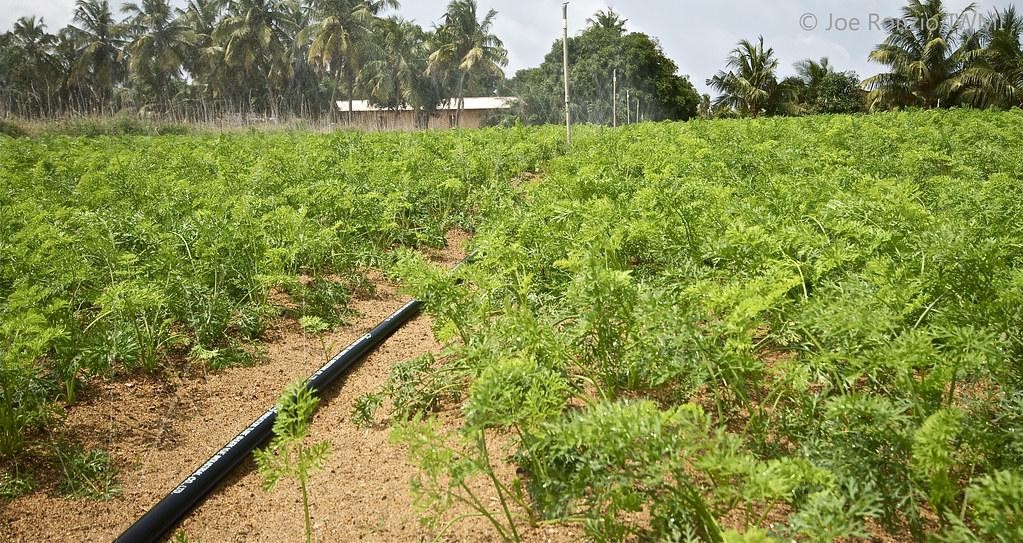One of the most promising climate-smart innovations for dryland farming in arid regions is still out-of-reach for the vast majority of smallholder farmers. But the technology is still relatively young, and a breakthrough might yet make it more accessible.
Numerous studies have confirmed that global warming is punishing farmers through rising temperatures, unpredictable rainfall, and longer droughts–which can lead to famines. Irrigation is expensive and impractical in many areas, while drought-resistant crops tend to yield less. Dryland farming techniques to help soils retain water have been around for thousands of years, but several new techniques developed in recent years hold special promise. One, already widely adopted in the United States, is reduced tillage, where crop residues help to slow evaporation from soil. But an even newer concept involves placing a liner beneath soils to prevent subsurface water from percolating away–subsurface water retention technology or SWRT.
What’s subsurface water retention technology?
When it does rain in an arid region, water is lost to deep percolation as well as evaporation and transpiration, particularly in sandy soils with low levels of clay and organic matter. SWRT installs a subsurface barrier to slow this process. Experiments in the 1960s tried to make it work using bulk materials like clay and asphalt, but nothing came of it. Then in the middle of the last decade, researchers started mulling ways to use lightweight but durable membranes installed in a V or U shape. This more modern version of SWRT technology has already been proven in the lab.
Impressive results
A few years ago, a team of researchers at Baghdad University in Iraq experimented with chili peppers grown in sandy soils in tightly controlled greenhouses conditions under precise irrigation schedules meant to mimic the surrounding arid climate. The performance of chili peppers grown with SWRT was compared to chili peppers grown organically, under no-till conditions, and against a control group grown via traditional tillage methods. Their SWRT chili peppers demonstrated the best growth overall. “SWRT performance was much better than other treatments as a result of polyethylene membrane. The range of water-saving under SWRT treatment ranged between 22-51% in comparison with the control treatment,” they reported in the Journal of Environment and Earth Science (https://www.iiste.org/Journals/index.php/JEES/article/view/3499). The same team ran a similar experiment a year later, growing tomatoes in sandy soils instead. Again, the SWRT tomatoes grew better and yielded more fruit. A similar study in Iran showed SWRT improving maize crop performance in sandier soils.
Field experiments are now underway, including one notable project in Zimbabwe. There, Professor George Nyamadzawo of Bindura University and colleagues secured funding from the Swedish Research Councils and the Swedish University of Agricultural Sciences to study the efficacy of SWRT on smallholder farm plots in the community of Marange. Thus far, they have found taller plants and higher yields on SWRT than on control plots. The “Productive Sands” project was launched in 2019 and is scheduled to continue until 2023, but initial results are already causing buzz—project managers held a field day event last year in a bid to draw more attention and raise awareness of SWRT, but they soon found the community was already plenty aware. “More than 300 smallholder farmers registered to be considered for new installations of the technology on their farms if resources are available,” SLU reported in a release (https://www.slu.se/en/ew-news/2021/6/hundreds-of-smallholder-farmers-queueing-for-climate-smart-agriculture-technology/).
And there’s the catch: if resources are available, meaning if there’s money.
Cost is king
As it stands now, installing SWRT is expensive and labor-intensive. It involves digging trenches 30-80 cm deep and moving all soil above that level to the side while laying a membrane, designed to last up to 50 years. Ideally, rows lined with SWRT are marked such that farmers know where to plant. It’s simpler than burying asphalt, but still an involved process for smallholder farmers with meager resources.
Last April, a team from Italy showcased a more efficient SWRT installation technology at the European Biomass Conference and Exhibition. Their machine is essentially a large trench digger pulled by a tractor that carves a deep V-shaped ditch some 100 cm deep into a farmer’s field. As the ditch is dug a roller lays an impermeable “film” or membrane into the hole. The same machine then buries the membrane after it’s laid with the excavated soil, completing the installation in one run. At least that’s the idea. Field trials are planned for farms in Egypt and Morocco, but some kinks need to be worked out. “The prototype, in the current condition, is not fully able to collect the soil expelled from the rotors,” the development team reported. As a result, much of the ditch remains open and unfilled, requiring someone to fill it in manually using a shovel.
“SWRT is characterized by high initial financial and labor investment costs.”
Grow Further is considering supporting research to continue to develop SWRT and make it more accessible to smallholder farmers. Compared to building irrigation systems, or suffering from the consequences of climate change-induced droughts without it, the development costs are likely to be quite modest.
— Grow Further
Photography credit: Sandy soil field irrigation in Ghana. International Water Management Institute, Creative Commons




